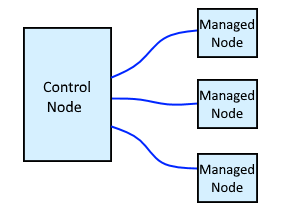
Tasks are run against target servers. Some Ansible documentation refers to the target servers as "hosts".

After a clean install of Ansible, the "inventory" directive in ansible.cfg is commented out, like this.
#inventory = /path/to/hosts
In this scenario, the default hosts file is /etc/ansible/hosts and the default hosts file is completely commented out. If you were to issue command ansible all -m ping, the following would be displayed. Likewise, if you were to uncomment the "inventory" directive in ansible.cfg without defining your inventory, the following would be displayed.
[WARNING]: provided hosts list is empty, only localhost is available. Note that the implicit localhost does not match 'all'
Typically, target servers are defined in the default hosts file or your own inventory file. Sometimes, the "inventory" directive in ansible.cfg is uncommented and updated to point to the directory where the default hosts file or your own inventory file will be located.
Additionally, Ansible uses inventory plugins to parse inventory. The ansible-doc command can be used to list the inventory plugins that can be used with the version of Ansible you are using.
~]$ ansible-doc --type inventory --list
ansible.builtin.advanced_host_list Parses a 'host list' with ranges
ansible.builtin.auto Loads and executes an inventory plugin specified in a YAML config
ansible.builtin.constructed Uses Jinja2 to construct vars and groups based on existing inventory
ansible.builtin.generator Uses Jinja2 to construct hosts and groups from patterns
ansible.builtin.host_list Parses a 'host list' string
ansible.builtin.ini Uses an Ansible INI file as inventory source
ansible.builtin.script Executes an inventory script that returns JSON
ansible.builtin.toml Uses a specific TOML file as an inventory source
ansible.builtin.yaml Uses a specific YAML file as an inventory source
For example, ansible.cfg may have the following. This assumes you have yaml as one of the enabled_plugins in ansible.cfg. Let's say you have advanced_host_list as one of the enabled_plugins in ansible.cfg.
[inventory]
enable_plugins = ansible.builtin.advanced_host_list, ansible.builtin.yaml, ansible.builtin.ini
The ansible command with the --list-hosts and -vvv flags can be used to determine if the advanced_host_list plugin is being used.
AVOID TROUBLE
You must include the trailing comma after the managed node hostname
ansible all -i "server[1:10].example.com," --list-hosts -vvv
If you get something like this, this suggests you did not define advanced_host_list in ansible.cfg properly.
Unable to parse address from hostname, leaving unchanged: Detected range in host but was asked to ignore ranges
If the following is returned, the advanced_host_list plugin is being used.
Parsed server[1:10].example.com, inventory source with advanced_host_list plugin
Something like this should be returned.
hosts (10):
server1.example.com
server2.example.com
server3.example.com
server4.example.com
server5.example.com
server6.example.com
server7.example.com
server8.example.com
server9.example.com
server10.example.com
Or, the ansible-inventory command with the --list option can be used.
ansible-inventory -i "server[1:10].example.com," --list
Or, the ansible-inventory --list command can be used.
ansible-inventory -i "server[1:10].example.com," --list
Or, the ansible-inventory --graph command can be used.
ansible-inventory -i "server[1:10].example.com," --graph
Did you find this article helpful?
If so, consider buying me a coffee over at 